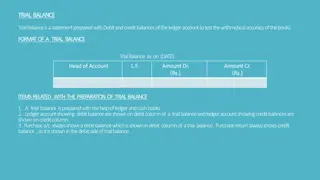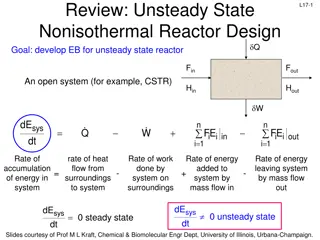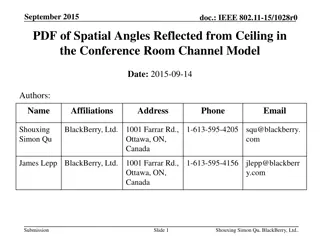
Analytical Balances Overview
Learn about the different types of analytical balances, such as electronic balance, single pan mechanical balance, semi-micro & microbalances, and two-pan analytical balance. Understand the importance of accurate weighing in analytical chemistry and the transition from traditional to digital balances for precise measurements. Discover the functionalities of electronic balances and how they have revolutionized the weighing process with error-free operation, speed, and digital display.
Download Presentation

Please find below an Image/Link to download the presentation.
The content on the website is provided AS IS for your information and personal use only. It may not be sold, licensed, or shared on other websites without obtaining consent from the author. If you encounter any issues during the download, it is possible that the publisher has removed the file from their server.
You are allowed to download the files provided on this website for personal or commercial use, subject to the condition that they are used lawfully. All files are the property of their respective owners.
The content on the website is provided AS IS for your information and personal use only. It may not be sold, licensed, or shared on other websites without obtaining consent from the author.
E N D
Presentation Transcript
TYPES OF ANALYTICAL BALANCES Presented by Dr. Mrs. C. S. Patil Professor & Head Department of Chemistry Vice-Principal Deogiri College, Aurangabad
TYPES OF ANALYTICAL BALANCES TYPES OF ANALYTICAL BALANCES There are three types of Analytical balances .Those are the type as mentioned below, ELECTRONIC BALANCE SINGLE PAN MECHANICAL BALANCE SEMIMICRO & MICROBALANCES TWO PAN ANALYTICAL BALANCE
GENERAL GENERAL OVERVIEW OF THE OVERVIEW OF THE ANALYTICAL BALANCE ANALYTICAL BALANCE Always the Analyst requires the Sample or the Standard solutions to analyse the substance or the given sample in the laboratory Qualitatively or quantitatively. To achieve this accurate weighing is the main procedural part in the lab,to go with it we requires an analytical balance to perform the weighing accurately & precisely. So as mentioned above we can have the choice of any one of the balance to complete the weighing.
CONTINUED CONTINUED The Chemical Analyst in fact deals with the mass rather thanWeight. Mass is the quantity of matter of which the object is composed of & is invariant. Weight of an object is nothing but it is the force exerted on it by gravitational attraction. This force will differ at the different locations on the earth,so we can write as, W = mg Where W = weight of the object (M)is the mass &( g) is the acceleration due to gravity
CONTINUED CONTINUED Now a days The Analytical Balance has undergone the radical change. Two pan Analytical Balance has become old technique for the weighing process. so digital balances are widely used for the weighing purposes. So as shown in the first slide we can have better option to go with the weighing process.
ELECTRONIC BALANCE ELECTRONIC BALANCE
ELECTRONIC BALANCE ELECTRONIC BALANCE These balances are error free balances. Easy to operate as compared to Mechanical balances. Speedy operation. These are digital balances ,so display will be fast. There is no need to adjust pointer swings,knife edges, beam position etc as in mechanical balance. Electromagnetic force,electrical position scanner & microcompressor collectively converts the signals in to perfect weight,which can be digitally visualised. The weight of the container will be subtracted automatically.
ELECTRONIC BALANCE ELECTRONIC BALANCE Asingle control bar is used to switch the balance on & off to set the display to zero & container weight will be automatically nullified. Since the result is available as the electrical signals they can be readily processed by a personal computer & STORED . The weighing statistics can be automatically calculated. Different types of electronic Analytical balances are available in the market which provides different ranges & readabilities.
ELECTRONIC BALANCE ELECTRONIC BALANCE A microbalance will have a range of the order of 160 gm readable to 0.1 mg. A semi microbalance will havea range of about 30 gm readable to 0.01 mg. Microbalance weight up to 1 microgm. Ultra microbalance are available that are sensetive to 0.1 micro gram or less. Electrochemical quartz balances are available with 100 micro gram range that can detect1 nanogram i.e 10 -9 gm.
SINGLE PAN BALANCE Single pan balances are advanced balances & all Analytical Laboratories now a days are well equipped with the Single Pan Balances. These balances bear only one pan to place the object. It is perfectly counter balanced by a fixed weight on the other side of the beam which is called as air damper. All single pan balances are always under the load of fixed weights ,generally the range is 160 to 200 gm During the weighing process the coincidence of the vernier scale & main scale is observed.
CONTINUED These balances are working on the basis of principle of electromagnetic forces compensated as described by the Angstorm in 1895. The addition of the weights & removal of the weights are done by rotating the control knob. The zeroed position is determined as usual in the two pan ANALYTICAL Balances. All weights of a single pan balances are concealed & are removed by means of control knob on the front panel of the balance. There are three knobs one for gram ,second for the fraction of the gram & third one is for the fraction of the miligrams.
CONTINUED For example first knob adds 10 to 90 gm. Second Knob adds 1 gm to 9 gm. Third Knob is for the 0.1 gm to 0.9 gm. Accordingly the weights are added as the need. Care should be taken,not to damage the knife edges & pans while adding & removing the weights . There are three knife edges ,two terminal & one is central. The centre position arrests the pan & beam. Second Position partially releases the pan for use while finding the approximate weight of the object on the pan. Third position edge completely releases the pan to allow the balance to come to rest.
SEMIMICRO AND MICROBALANCES Semimicro balance is sensitive to about 0.01 mg. Microbalance is sensetive to about 0.001mg ( 1microgm). The load limit for these balances are comparatively less than conventional balance & greater care must be taken in their use.






















